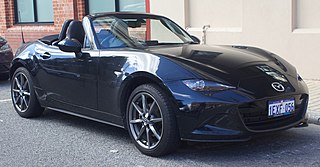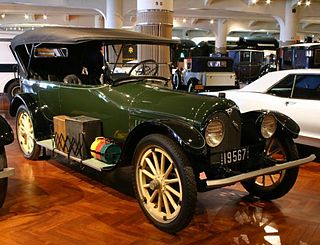

The Ben-Hur Motor Company was incorporated in 1916 in the state of Delaware, with the cars being built by L. L. Allyn in Willoughby, Ohio.


The Ben-Hur Motor Company was incorporated in 1916 in the state of Delaware, with the cars being built by L. L. Allyn in Willoughby, Ohio.
Ben-Hur exhibited a cloverleaf roadster at the 1917 New York Auto Show. [3] In February 1918 Allyn announced that between 30 and 40 cars had been shipped to dealers, and that plans called for five to ten cars a week for the time being, owing to the difficulty in securing bodies. The company had a factory with a capacity of building 20 cars per day. A meeting was scheduled in March to increase capitalisation, but by May 1918 the company was in receivership. [4]
| | This article about an automotive industry corporation or company is a stub. You can help Wikipedia by expanding it. |

Marmon Motor Car Company was an American automobile manufacturer founded by Howard Carpenter Marmon and owned by Nordyke Marmon & Company of Indianapolis, Indiana, US. It was established in 1851 and was merged and renamed in 1933. They produced cars under the Marmon brand. It was succeeded by Marmon-Herrington and later the Marmon Motor Company of Denton, Texas. The name currently survives through the Marmon Group of Chicago, Illinois.

A roadster is an open two-seat car with emphasis on sporting appearance or character. Initially an American term for a two-seat car with no weather protection, usage has spread internationally and has evolved to include two-seat convertibles.

The Alter Motor Car Company, of Plymouth, Michigan, produced over 1,000 automobiles between 1914 and 1916.

The Apperson was a brand of American automobile manufactured from 1901 to 1926 in Kokomo, Indiana.

The Stutz Bearcat was an American sports car of the pre– and post–World War I period.

Templar was a manufacturer of automobiles in Lakewood, Ohio from 1917 to 1924. The company was named for the Knights Templar and used a Maltese Cross as an emblem.

The Lexington was an automobile manufactured in Connersville, Indiana, from 1910 to 1927. From the beginning, Lexingtons, like most other Indiana-built automobiles, were assembled cars, built with components from many different suppliers. The Thoroughbred Six and Minute Man Six were popular Lexington models.

The Westcott was an automobile produced in Richmond, Indiana and Springfield, Ohio in the United States between 1909 and 1925 by the Westcott Motor Car Company. The car company was named for its founder, John Westcott.
Crane-Simplex was a car manufacturer, operating in New York City and New Brunswick, New Jersey, at the beginning of the 20th century.

Barley Motor Car Co. was a manufacturer of automobiles in Kalamazoo, Michigan, and Streator, Illinois. It manufactured the Roamer automobile (1916–29) and, briefly, the Barley (1922–24), and the Pennant (1924–25).

The Grant Motor Co was an American automobile manufacturing company which produced automobiles from 1913 to 1922. The company was based in Findlay, Ohio. The company produced several thousand four and six cylinder automobiles and even exported cars to England as the Whiting-Grant. In 1916, a five-passenger touring car produced by the company sold for US$795.
The Sun automobile was made in Elkhart, Indiana from 1916 to 1917, and in Toledo, Ohio from 1921 to 1922.

Scripps-Booth was a United States automobile company based in Detroit, Michigan. Established by James Scripps Booth in 1913, Scripps-Booth produced motor vehicles and was later acquired by General Motors, becoming a division of it, until the brand was discontinued in 1923.

The Cole Motor Car Company was an early automobile maker based in Indianapolis, Indiana. Cole automobiles were built from 1908 until 1925. They were quality-built luxury cars. The make is a pioneer of the V-8 engine.
The Yale was a Brass Era car manufactured in Saginaw, Michigan from 1916 to 1918, not to be confused with the Yale from Toledo, Ohio.
The Buick Standard Six was manufactured by Buick of Flint, Michigan, and was the junior model to the Buick Master Six between 1925 through 1929, and shared the GM A platform with Oldsmobile, Oakland and Chevrolet. When the Buick 4-cylinder engine was cancelled it was the most popular Buick sold while being more upscale to the Oldsmobile Six. It was replaced by the Buick Series 40 in 1930, and was the senior brand to Marquette under the General Motors Companion Make Program until it was cancelled one year after introduction. It replaced the earlier Buick Six that was introduced in 1916, and was replaced with the Buick Special.

The Cunningham automobile was a pioneering American production automobile, one of the earliest vehicles in the advent of the automotive age. It was produced from 1896 to 1931 in Rochester, New York by James Cunningham, Son and Company.

The Royal Mail models H-2 (1914–15) and H-2½ (1916), the Amesbury Special model H-3 (1915) and the Baby Grand model H-4 (1914–16) were American cars made by Chevrolet. It was replaced by the Chevrolet Series F in 1917.

The Commonwealth Motors Corporation was a luxury auto company that produced cars from 1917 to 1922. The company was founded in Chicago as Partin-Palmer company in 1913, but in 1915 got into financial trouble. So, in 1917, the name was changed to Commonwealth, and production was moved to Joliet, Illinois.
The Oldsmobile Light Eight was built from 1916 through 1923. The Light Eight was the first Oldsmobile to use a sidevalve V8 engine. The Light Eight was offered as Oldsmobiles top level car after the Oldsmobile Limited was discontinued. It replaced the Oldsmobile Limited introduced in 1912, and was replaced by the General Motors Companion Make Program Viking introduced in 1929. The engine used was the Cadillac L-head engine, and shared a platform with the Buick Six, while all bodies were supplied by Fisher Body. It was more expensive than the market favorite Ford Model T but it did offer the durability of a V8 and a wider range of bodystyles offered.